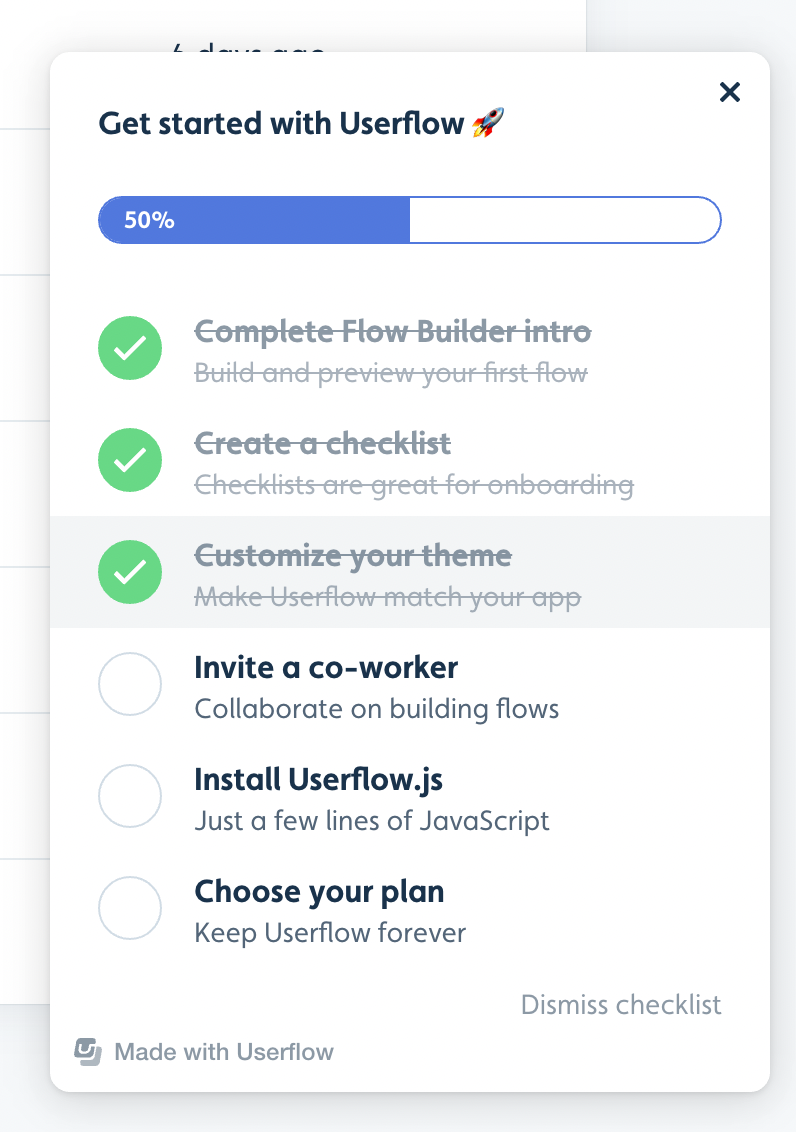In the last blog post, I presented the decision on whether the onboarding should be Sales-led, product-led or hybrid. In this 4th part of our blog post series about SaaS onboarding we will get to the fun part of actually building the onboarding flow. This post will not go deep down in specifics on how you should build the flows, as that depends on your customers. Instead, I will give you 5 high-level things to consider in your approach.

1 - Look at what others are doing
The first key step is to go out and experience what other similar SaaS businesses are doing. You are not the first person to build a SaaS onboarding flow, so use this to your advantage. Sign up for demos, trials, etc., and learn. You might come across some cool products while doing this.
Instead of signing up for every single service out there, there are also great sites that give you onboarding teardowns. Some of my favorites are Productled’s onboarding teardowns and Useronboard. Both of these sites give a critical review of onboarding flows, and it is a great place to learn what to do/not to do.
2 - Do Small Iterations
Even though SCRUM and agile have been around forever, many companies still fall into the trap of building features and onboarding flows in a waterfall model. While I recommend you do customer research, segmentation, and journey maps. You may have to try something without knowing if it will go well, however, I am not a believer in the launch of the ugly babies approach that many preach. Instead, I recommend doing small quality iterations. For example, one can start by building a simple “Get Started” checklist into the product using a 3rd party tool like Userflow.
3 - Achieve your goal by delivering ”Aha” moments
When you start building your onboarding, you should make sure your onboarding flow achieves the goal you originally set out to reach, as described in our first blog post.
Showing off all your product’s features won’t drive users to reach their goals. It may just annoy your users. But during your research (as described in our 2nd blog post) and while iterating on the onboarding flow you will discover key ”Aha” moments, which are user adoption/conversion triggers that lead to you achieving the goal. Often there is more than one trigger, and it’s key to identify them and properly use them as part of your onboarding flow.
Examples of “Aha moments” could be
- A customer touches feature x and finds out that it is 10x better than what they have seen before.
- A customer creates an integration successfully in 2 min. And finds out the tool is easy
- A customer x creates a piece of content and finds out they can do it in a way that perfectly fits their needs.
Some of Userflow’s key features are the usability of our flow builder as well as some of our advanced customizations. Therefore two of our key onboarding items to achieve our goal of trial conversion is to get the user to create a flow as quickly as possible and to show our ability to align with your company’s theme..
4 - Use different onboarding tools
As mentioned in the introduction, I will not dive into the deep details of building the actual onboarding flow. But below I will give some pointers to tools to use:
- Onboarding meetings (Sales-led model)
- Welcome email(s)
- Trial/Onboarding follow-up emails with tips and tricks
- In-app onboarding checklists, that structures the onboarding process
- In-app guides that guides the user through each task in the onboarding checklist
- In-app feature highlights, that guides users to look at certain features in a non-intrusive way.
The key aim of these things should of course be to drive the user to adoption and “Aha” moments. As mentioned in the previous section, two of the key “Aha” moments for Userflow are the ease of using our flow builder, as well as our advanced theme editor, therefore introducing the user to those are two key tasks on our onboarding checklist.

If you want to dive deeper into some of the tools for a more product-led approach, then I highly recommend you check out the checklist and guides below from productled.com.
5 - Consider Support/Help Desk
No onboarding flow will ever be perfect, thus having some form of support either via customer success or a help desk is a great way to allow the customers to ask questions after they have been onboarded. Again the decision of whether to mostly use a help desk combined with chat vs. a more Customer Success-driven approach depends on your goal and target segment for that goal.
No matter the approach I would argue that having a strong self-service help desk baseline can save your customer success team hours and also ensure that customer success follows a common public material to guide the customers.
If your end goal is trial conversion, you can consider having specialized sales personnel manage the chat, instead of Customer Success. Either way, the aim remains the same. Support the customer to lead them to their “Aha” moments and achieve success.
Next Step
As you now start building your onboarding, it is key to track its performance and how it helps improve the goal you originally set. Therefore, in the next and last blog post of this series, we will focus on how you can measure the success of your onboarding flow.
